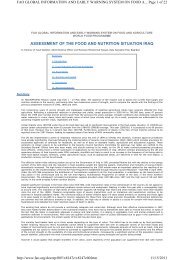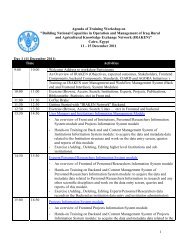Vermiculture in Egypt: - FAO - Regional Office for the Near East and
Vermiculture in Egypt: - FAO - Regional Office for the Near East and
Vermiculture in Egypt: - FAO - Regional Office for the Near East and
Create successful ePaper yourself
Turn your PDF publications into a flip-book with our unique Google optimized e-Paper software.
aquaculture started to exert some significant dem<strong>and</strong> on fish feed. In 2001, <strong>the</strong>re are<br />
twelve feed mills that produced about 68 500 tons of specialized feeds. Most of feeds<br />
are produced <strong>for</strong> self-sufficiency to support <strong>the</strong> needs of Governmental fish farms, but<br />
some quantities are available <strong>for</strong> sale to private sector. Because of <strong>the</strong> cost, such mills<br />
produce fish feeds of 18-32% prote<strong>in</strong> of s<strong>in</strong>k<strong>in</strong>g type pellets, however, higher prote<strong>in</strong><br />
float<strong>in</strong>g feeds could be produced upon request. High quality fish meal provide <strong>the</strong><br />
major component <strong>in</strong> <strong>the</strong> commercial fish feeds <strong>and</strong> may constitute up to 60% of <strong>the</strong><br />
total diet <strong>for</strong> mar<strong>in</strong>e species, with higher levels be<strong>in</strong>g used <strong>in</strong> starter <strong>and</strong> f<strong>in</strong>gerl<strong>in</strong>g<br />
rations. Generally, a good range of raw materials is available <strong>for</strong> fish manufacture <strong>in</strong><br />
<strong>Egypt</strong>. However, price <strong>and</strong> competition from <strong>the</strong> human food <strong>and</strong> animal feed<br />
<strong>in</strong>dustries limits <strong>the</strong> choice. High quality feed materials are <strong>in</strong> short supply <strong>and</strong> are<br />
expensive. Apart from fish meal (imported <strong>and</strong> <strong>in</strong>digenous), <strong>the</strong> ma<strong>in</strong> available<br />
prote<strong>in</strong> sources are: soybean meal (hexane-extracted), cottonseed meal (expeller),<br />
meat meal, poultry offal meal <strong>and</strong> fea<strong>the</strong>r meal. O<strong>the</strong>r possibilities <strong>for</strong> new feed<br />
materials may be <strong>the</strong> wide spread mar<strong>in</strong>e macroalgae or fresh water weed hyac<strong>in</strong>th.<br />
On local basis, <strong>the</strong>re is a scope <strong>for</strong> <strong>the</strong>ir <strong>in</strong>corporation <strong>in</strong>to fish feeds particularly <strong>for</strong><br />
tilapia <strong>and</strong> mullets. Tables 6.6 <strong>and</strong> 6.7 show <strong>the</strong> proximate composition of <strong>the</strong> tested<br />
feed <strong>in</strong>gredients, namely: acid fish silage (AFS), fermented fish silage (FFS), soybean<br />
meal (SBM), a mixture of FFS <strong>and</strong> SBM (MIX), green macroalga Ulva meal (UM)<br />
<strong>and</strong> red macro-algae Pterocladia meal (PM) compared to fish meal (FM) from<br />
different sources <strong>and</strong> <strong>the</strong>ir am<strong>in</strong>o acid profiles, respectively.<br />
Table 6.6. Composition (%dry matter) of tested prote<strong>in</strong>s sources or supplements <strong>for</strong><br />
fish feeds<br />
Ingredient Prote<strong>in</strong> Lipid Ash Moisture NFE Fiber DE<br />
AFS1 72.90 13.12 12.76 73.28 1.22 - 164<br />
AFS2 73.40 17.10 8.30 - 1.20 - 178<br />
AFS3 63.00 22.10 9.68 75.00 - - 177<br />
FFS 56.67 12.7 20.04 0.98 - - 135<br />
SBMG 44.80 20.60 5.40 5.50 29.20 - 161<br />
SBMB 44.00 1.80 8.00 8.94 37.26 - 103<br />
SBMD 44.00 4.00 6.53 11.00 38.17 7.30 110<br />
UM 17.44 2.5 32.85 3.69 41.47 5.47 64<br />
PM 22.61 2.18 37.3 3.05 28.29 9.62 35<br />
FM1 72.05 10.94 7.00 5.00 8.98 1.02 160<br />
FMD 61.00 8.95 20.72 6.20 9.73 - 136<br />
FMD 61.00 5.00 16.60 5.00 16.70 0.70 127<br />
Source: Wassef (2005).<br />
NFE: Nitrogen free extract, by difference; DE: Digestible energy (MJ/Kg); AFS: acid fish silage;<br />
FFS: fermented fish silage; SBM: boiled full fat soy meal (G: germ<strong>in</strong>ated; B: boilled fullfat; D:<br />
defatted); MIX: mixture of FFS <strong>and</strong> SBM; UM: Ulva meal; PM: Pterocladia meal; FM: fish meal (D:<br />
domestic product; I: imported Manhaden).<br />
60





